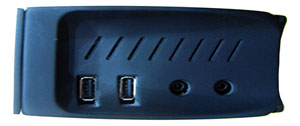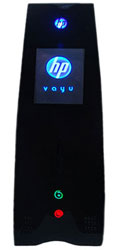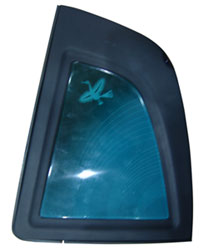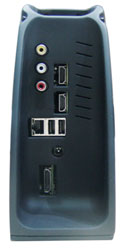HP Labs India
| Vayu Internet Device (VInD) |
Vayu internet Device (VInD) is hardware platform with flexibility to grow from a basic very low-cost configuration to a high-end multimedia configuration (See Fig 4). VInD is an always ON device which connects to TV and Internet.We believe that there would be less resistance to migrate to a broadband Vayu device from a mobile phone than making a transition to a traditional computer. The VInD is a stationary platform with interfaces to external displays, TV, a keyboard, a sensor bar, cameras, printer, scanner and other peripheral devices (Fig 2 Vayu Hardware Ecosystem ), which optionally a user want to connect to VinD.
The default interaction with the VInD is using a universal remote control (IR-based) Optional accessories will enable the multimodal experiences as defined in VUE. A small built-in secondary display (3-4 inch diagonal) and built-in speakers are used for enabling notifications to the user when the TV is OFF or being used to consume broadcast content
VInD Industrial Design and the living room setup ![]()
The design guidelines for VinD are:
- Enabling a set of rich user experiences that meet the everyday needs of the target segment
- Pairing of the mobile with VInD at home or work (whether in the close proximity of the VInD or beyond the range in the unlicensed band)
- Supporting for multimodal intuitive interaction
- Multi-Vayu homing on a single VInD
- Integration with broadband access, sensor bar, 3-D camera, and other auxiliaries.
The VInD comes with built in Zigbee host, USB ports, Wi-Fi b/g/n, Ethernet and Bluetooth 2.1, infrared connectivity. Connectivity to the TV is provided via HDMI and component signal ports. It also supports GPRS, 3G and HSDPA and has in-built speakers. The VAYU Internet Device supports various AV codecs many of which are hardware accelerated. To keep the solution relevant to emerging markets, we have paid specific attention to keep the unit cost within acceptable limits.
The aim of the VinD prototype was to be able to demonstrate a user experience for living rooms in the emerging markets at a reasonable price point. While we wanted to explicitly support features like pairing with mobile phones, packaged-web interaction and interaction modalities like paper-based interactions and gestures, we wanted to accomplish this at a reasonable cost. We believe that we have been successful in demonstrating that rich interactions and modalities may not necessarily come at a high price point. Unlike other products available in the market today, VinD supports multimodal interactions and paired interactions with mobile device - no matter where they are. In recognition of the fact that in many homes, this may be the only at-home computing device. VinD also supports (HD) video conferencing, (HD) media playback and a host interface for ZigBee to enable smart homes for e.g. security and lifestyle choices - note again our emphasis that rich user experiences do not necessarily mean a higher price point. Finally, we have designed VinD to be an open platform. Any HTML5 application can be used on VinD and we do not require tie up with any service provider since VinD can connect to the TV independent of the set-top box - either via HDMI port or via composite Video.
 |
 |
| Top View | Front View |
 |
 |
| Side View | Rear View |
| Fig 4: VInD |
This page was last updated on February 6, 2012